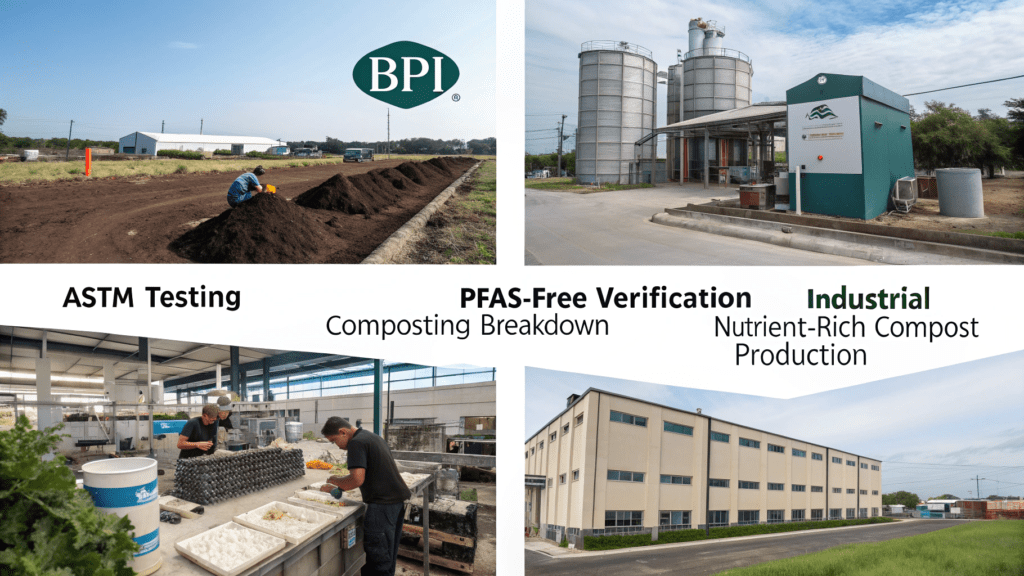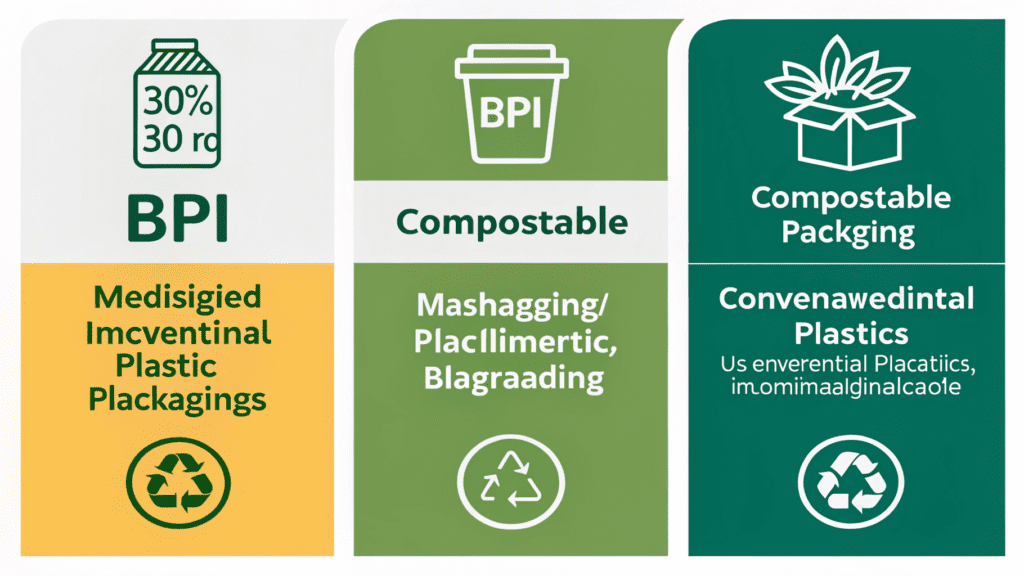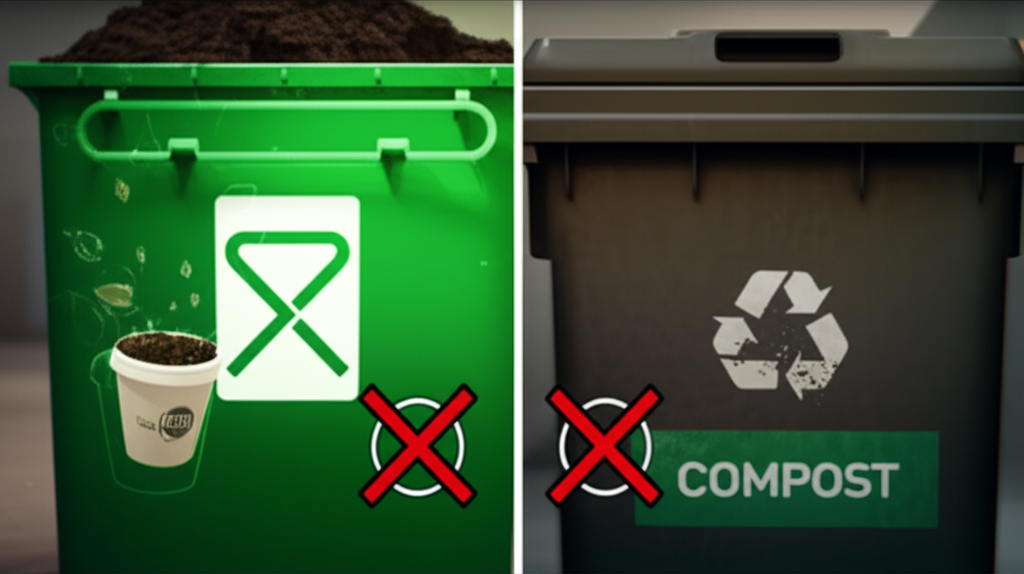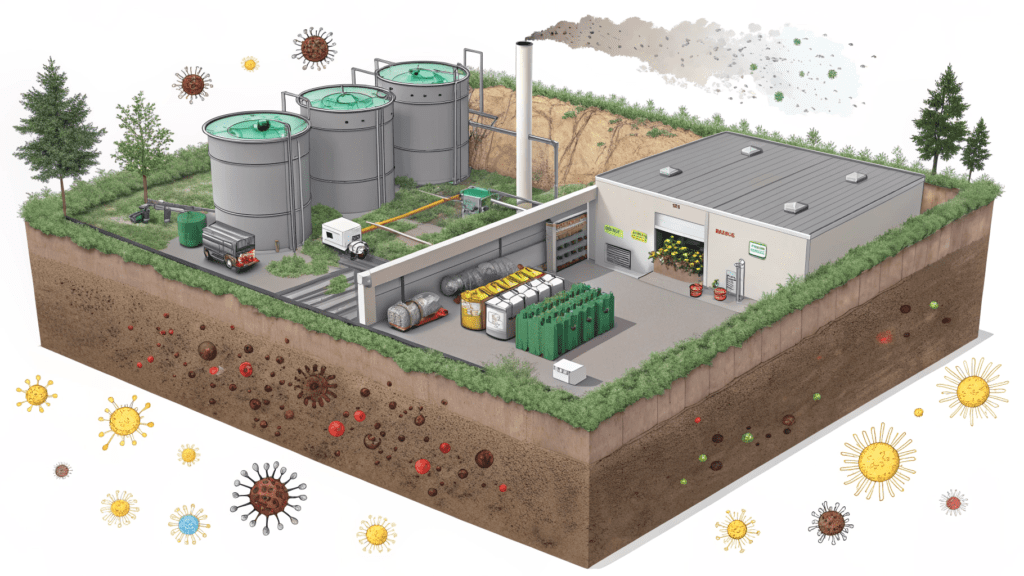
Navigating BPI Compostable Solutions: A Strategic Imperative for Businesses
Businesses across sectors are facing an unprecedented surge in pressure to adopt sustainable practices. From evolving regulatory landscapes to heightened consumer and stakeholder expectations, the shift towards eco-conscious operations is no longer optional but a strategic imperative. The global compostable packaging market is a testament to this irreversible trend, projected to reach a staggering$113.88 billion by 2030with a Compound Annual Growth Rate (CAGR) of 6.5%. This exponential growth underscores a clear market signal: sustainable packaging solutions are rapidly becoming mainstream.
At the forefront of this transformation in North America stands BPI (Biodegradable Products Institute). Established in2002as a non-profit, multi-stakeholder association, BPI offers the “gold standard” for compostable products. For procurement managers, operations directors, sustainability officers, and supply chain executives in theOdvětví pohostinství a potravin, understanding and leveraging BPI certification is paramount. It’s not just about meeting environmental goals; it’s about safeguarding brand reputation, ensuring regulatory compliance, and unlocking operational efficiencies that drive competitive advantage in a rapidly evolving market. This comprehensive playbook empowers B2B decision-makers to effectively integrate BPI-certified materials into their sustainable waste management strategies, transforming challenges into opportunities for growth and environmental stewardship.Embracing BPI compostable solutions is a strategic imperative for hospitality and foodservice businesses.
Decoding BPI Compostable: Certification & Compliance for B2B Decision-Makers
Understanding the intricacies of BPI certification is foundational for any business committed to genuine sustainability. BPI is a non-profit organization dedicated to ensuring that products meet rigorous scientific standards for compostability. Specifically, BPI-certified products must comply with ASTM D6400 (for compostable plastics) or ASTM D6868 (for biodegradable plastics used as coatings on paper and other compostable substrates). These stringent standards mandate a minimum of90% biodegradation within 90 daysin industrial composting facilities, without leaving any toxic residue.
This scientific rigor is crucial because it addresses a significant industry pain point: the pervasive issue of “greenwashing.” The market is flooded with vague and often misleading claims such as “biodegradable” or “degradable.” Unlike BPI compostable products, these items often lack verifiable standards for complete breakdown and can leave behind microplastics or harmful residues, undermining true environmental efforts. For instance,California AB 1201specifically bans uncertified “biodegradable” claims, highlighting the legal and reputational risks associated with non-compliant marketing. The official BPI swirl logo is therefore the key for identification, signaling compliance and providing assurance to both businesses and composting facilities that a product will truly break down. This distinction is vital for accurate waste stream diversion and preventing costly contamination. To delve deeper into these critical differences, refer to our comprehensive guide onBPI Compostable vs. Biodegradable: Průvodce udržitelností.BPI certification ensures genuine compostability, preventing greenwashing and ensuring compliance.

Operationalizing BPI Compostable: Maximizing ROI and Sustainability Impact
Integrating BPI-certified products into your operations is not merely an environmental gesture; it’s a strategic move that can yield tangible ROI and significant sustainability impact. The primary benefit lies in facilitating genuine organic waste diversion from landfills. When non-compostable items contaminate organic waste streams, it can cost the composting industry millions annually in terms of increased operational expenses for sorting and disposal. By ensuring only BPI-certified items enter the compost stream, businesses prevent this contamination, supporting the production of valuable, nutrient-rich soil.
This commitment to verifiable compostability also enhances brand integrity, a critical asset in an era of growing consumer demand for ethical and eco-conscious businesses. The global bioplastics market is projected to reach$33.3 billion by 2033, reflecting a CAGR of 10.18%. This growth is driven by increasing environmental awareness and a preference for eco-friendly products, underscoring that sustainability directly translates to market appeal and customer loyalty. Proper integration of BPI compostable materials can also lead to operational efficiencies and reduced waste disposal costs, especially in regions with established composting infrastructure. For B2B decision-makers in thehospitality sector, this shift is particularly relevant. Learn more about how to navigate these changes in our article onBPI Compostable Certification in Hospitality Sustainability.
Real-World Application: KFC Canada’s Commitment
Major corporations are already demonstrating the tangible benefits of this shift.KFC Canada, for example, has publicly aimed forall consumer-facing compostable packaging by 2025. This commitment showcases how integrating BPI-certified materials is a viable and impactful strategy for large-scale operations. Such initiatives not only align with sustainability goals but also resonate deeply with environmentally conscious consumers, strengthening brand perception and market position.
A Comparison: BPI Compostable vs. Conventional Packaging for B2B Operations
| Funkce | B2B Operační dopad | Poznámka dodržování předpisů | Potenciál návratnosti investic |
|---|---|---|---|
| BPI Compostable Packaging | Reduces landfill waste; supports organic waste streams; requires specific industrial composting infrastructure for proper breakdown; minimizes contamination in compost. | Meets ASTM D6400/D6868 standards; avoids “greenwashing” penalties (e.g., California AB 1201); aligns with evolving regulations like California SB 54 (all packaging recyclable/compostable by2032); can reduce future waste taxes/fees. | Enhanced brand reputation, attracting eco-conscious customers and partners; potential for reduced waste hauling costs where organics collection is available; improved ESG scores. |
| Conventional Plastic Packaging | Lower upfront cost; contributes significantly to landfill burden; lacks organic waste stream compatibility; poses long-term environmental concerns. | Faces increasing regulations (e.g., plastic bans inover 60 countries by 2024); contributes to environmental fines/PR risk from non-compliance; potential for future taxes/fees on plastic usage (e.g., plastic taxes in Europe). | Short-term cost savings; long-term brand risk due to negative environmental perception; vulnerability to future regulatory penalties and supply chain disruptions. |
BPI compostable products offer significant ROI through waste diversion and enhanced brand integrity.

The Core Directive: Disposing of BPI Compostable via Industrial Composting Facilities
The success of BPI compostable products hinges entirely on their proper disposal.Industrial composting facilities are theonlycorrect disposal routefor BPI-certified items. These facilities are specifically engineered to provide the high temperatures (often exceeding 130°F), optimal moisture, and controlled aeration needed for BPI-certified materials to achieve their mandated90-day breakdown.
For procurement and operations managers inhospitality and foodservice, this means a critical need to“Check Local Guidelines.”Municipal waste authorities are the definitive source for local composting rules. It is vital to confirm whether local programs and facilities accept BPI-certified plastics, as policies can vary significantly. For instance,Ann Arbor ceased accepting plastic BPI-certified items in 2024, now only accepting fiber and paper-based compostables. This highlights the dynamic nature of local infrastructure and the need for continuous vigilance.
Acrucial rule:DO NOTplace BPI compostable items in traditional recycling bins. They are fundamentally different from conventional plastics, metals, or paper. Made from plant-based materials like Polylactic Acid (PLA) or plant fibers, they require microbial action for breakdown, not mechanical recycling. Placing them in recycling bins contaminates the recycling stream, leading to increased processing costs and landfilling of otherwise recyclable materials. Similarly, backyard composting is generally unsuitable for BPI products due to insufficient and inconsistent conditions for complete material breakdown. Without access to an industrial composting facility or a local program that accepts BPI compostable items, the most responsible disposal method remains the regular trash, though the environmental benefits of composting are then lost.Industrial composting is the only correct disposal route for BPI-certified items.
Overcoming Hurdles: Challenges in BPI Compostable Infrastructure & Policy
Despite the clear benefits and growing market for compostable packaging, several systemic challenges impede the widespread adoption and effectiveness of BPI-certified solutions in thehospitality and foodservice supply chains.
Contamination remains a primary hurdle.When non-compostable items mistakenly enter the organic waste stream, they contaminate the compost, increasing operational costs for composting facilities by approximately17%in some cases, due to the need for manual sorting and removal. This issue stems largely from consumer confusion and inconsistent labeling. Indeed, a survey found that nearlya third of respondentsmistakenly put compostable packaging into recycling bins.
Limited access to industrial composting facilitiesposes another major challenge. Only an estimated15% of North American facilitiesare currently equipped to accept bioplastics. This infrastructure gap means that even when businesses procure BPI-certified products, the necessary end-of-life processing may not be available in their region, leading to landfill disposal and negating the intended environmental benefits.
Regulatory hurdles also persist. The ongoingUSDA National Organic Program (NOP) debateis a significant example; current rules prohibit compostable bioplastics in certified organic compost, forcing composters to screen them out if they wish to sell USDA-certified organic compost. Furthermore, while BPI certification is rigorous, it faces scrutiny. Expert opinions and debates persist regarding BPI’s role, including criticisms from organizations like Beyond Plastics concerning toxicity and board composition, which BPI refutes by highlighting its independent third-party testing process via DIN Certco and its strict standards, including the prohibition of intentionally added PFAS since 2020.
Strategic Solutions for Expanding BPI Compostable Adoption
Addressing these challenges requires a multi-pronged approach involving industry collaboration, policy advocacy, and public education:
- Standardized Labeling and Education Campaigns: Advocating for clear, standardized labeling, such as the How2Compost label, is crucial to reduce consumer confusion and improve sorting at the source. Robust education campaigns targeting businesses and consumers can significantly reduce contamination rates and ensure proper disposal.
- Infrastructure Development and Support: Supporting industry-wide efforts like the US Composting Infrastructure Coalition (USCIC) and legislative initiatives, such as the federal COMPOST Act, which provides grants for food scrap composting, is essential. The U.S. Senate’s Recycling and Composting Accountability Act (RCAA) also aims to improve data collection and explore national composting strategies, laying the groundwork for future infrastructure investments.
- Extended Producer Responsibility (EPR) Programs: Emphasizing the need for EPR programs, as mandated by California’s SB 54, can generate necessary funding for the expansion and improvement of composting infrastructure, shifting the financial burden from municipalities to producers. This aligns with broader efforts to achieve circular economy principles.
- BPI’s Pivotal Role: Underscoring BPI’s critical role in working with manufacturers and composters since 1999 to verify compliance with ASTM standards fosters composter confidence and ensures that certified products genuinely meet industrial composting requirements. This sustained collaboration is key to building a robust and reliable compostable supply chain. The certification for specific products like straws, for instance, reinforces trust in the market. More information on such product-specific certifications can be found at BPI Certified Compostable Straws: Hospitality Sustainability.
Overcoming BPI compostable hurdles requires collaboration, education, and infrastructure development.

The Growth Trajectory: Future of BPI Compostable in Sustainable Business
The future of BPI compostable materials in sustainable business is poised for significant expansion, driven by continuous innovation and a supportive policy environment. Market projections reinforce this optimistic outlook, indicating strong growth for compostable packaging, with some estimates reaching$132.86 billion by 2032at a CAGR of 6.51%. This growth is not just about volume but also about the evolution of materials.
Innovations in bioplastics, particularly advanced materials likePHA (Polyhydroxyalkanoates), offer promising solutions. PHA-based materials are industrially compostable, non-toxic, and crucially, do not generate microplastics, addressing key environmental concerns. These advancements are making compostable alternatives more versatile and economically viable across a broader range of applications relevant tofoodservice and hospitality.
Supportive legislation is also paving the way. The U.S. Senate’s aforementionedRecycling and Composting Accountability Act (RCAA), aimed at improving data collection and exploring national composting strategies, signals a growing federal commitment to composting infrastructure. Similarly, California’s ambitiousSB 54mandates that all packaging sold in the state be recyclable or certified compostable by2032, establishing a strong regulatory push towards sustainable materials.
BPI continues to guide this transition, actively collaborating with industry stakeholders—from manufacturers to composters—to align B2B practices with circular economy principles. As research into biodegradation and composting efficacy advances, the confidence in BPI-certified solutions will only strengthen. The trajectory is clear: BPI compostable solutions are central to achieving a truly circular economy, minimizing waste, and maximizing resource value.The future of BPI compostable materials is bright, driven by innovation and supportive legislation.
Často kladené otázky (FAQ)
What is BPI certification and why is it important for hospitality businesses?
BPI (Biodegradable Products Institute) certification ensures products meet rigorous ASTM standards for industrial compostability, breaking down within 90 days without toxic residue. For hospitality, it’s crucial for genuine organic waste diversion, avoiding greenwashing, enhancing brand reputation, and ensuring compliance with evolving regulations like California AB 1201.
How do I properly dispose of BPI-certified compostable items in my hotel or restaurant?
BPI-certified items must be disposed of in industrial composting facilities. Always check local municipal waste guidelines, as acceptance policies vary. Do NOT place them in traditional recycling bins or backyard compost, as this contaminates streams and prevents proper breakdown.
What are the ROI benefits of switching to BPI compostable packaging for foodservice operations?
Switching to BPI compostable packaging can enhance brand integrity, attract eco-conscious customers, potentially reduce waste hauling costs in areas with organic collection, and improve ESG scores. It also prevents costly contamination of organic waste streams, saving the composting industry millions annually.
Are there specific challenges in implementing BPI compostable solutions in large-scale hospitality settings?
Yes, challenges include consumer and staff confusion leading to contamination, limited access to industrial composting facilities (only ~15% in North America accept bioplastics), and evolving regulatory hurdles like the USDA NOP debate. Education and infrastructure development are key to overcoming these.
How can procurement managers ensure their BPI compostable product sourcing is effective and compliant?
Procurement managers should prioritize suppliers offering products with the official BPI swirl logo, verify local composting infrastructure, and educate staff on proper sorting. Staying informed on regulations like California SB 54 and supporting EPR programs will also ensure long-term compliance and impact.
Conclusion: Paving the Way for a Truly Circular BPI Compostable Economy
Navigating BPI compostable solutions is no longer a niche concern but a strategic imperative for modern B2B operations. By understanding the rigorous distinction of BPI certification, embracing proper industrial disposal protocols, and actively advocating for critical infrastructure development, businesses can unlock significant environmental and operational benefits. The robust growth of the compostable packaging market underscores a collective commitment to sustainability that permeates consumer demand, regulatory frameworks, and corporate social responsibility.
Businesses inhospitality and foodservicethat proactively assess their current waste streams, partner with BPI-certified suppliers, and educate their teams will be best positioned to drive sustainable change. This proactive approach not only enhances an organization’s environmental impact but also bolsters brand reputation, ensures long-term regulatory compliance, and secures a competitive edge in a market increasingly prioritizing eco-conscious practices.
Assessyour current waste streams,partnerwith BPI-certified suppliers, andeducateyour teams to drive sustainable change and enhance your organization’s environmental and commercial impact today.Proactive BPI compostable adoption enhances environmental impact, reputation, and competitive edge.






